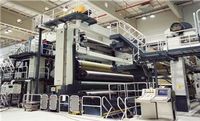Value Proposition
OMDEC is in the business of maintaining revenues, improving ROI and protecting customer satisfaction. It does that by identifying and predicting failures of critical equipment which will interrupt smooth deliveries of product or service. Our process calculates the cost of failure, defines the probability of failure within a given timeframe and measures the statistical confidence levels.
Read more about our values and visions...
Core Proposition:
-
OMDEC is in the business of maintaining revenues, improving ROI and protecting customer satisfaction.
-
It does that by identifying and predicting failures of critical equipment which will interrupt smooth deliveries of product or service
-
Our process calculates the cost of failure, defines the probability of failure within a given timeframe and measures the statistical confidence levels.
-
This allows Executives to make an informed decision on whether to approve a short PM outage, or risk a longer and more expensive breakdown.
-
The deliverable to the customer is a combination of software, training and a new approach to understanding how to optimize plant downtime.
Background:
1. To do this, we require data that is relatively consistent and relatively accurate. This is always an issue with Reliability Engineers. Historically data has been neither consistent nor accurate.
2. OMDEC solves this problem with LRCM (Living RCM).
3. LRCM amalgamates data from three sources:
- i. Past history – from the CMMS or EAM or ERP
- ii. Current status – from the Condition Based Monitoring systems
- iii. Expectations – the Reliability Centered Maintenance database
4. From this it will create a Reliability Knowledge base which is the source of data for many types of reliability analysis
5. One key analytical tool is EXAKT. EXAKT statistically links the causes of failure with the failure point to produce a Remaining Useful Life, a probability of failure and confidence levels.
6. To deal with risk, OMDEC uses the simple formula:
Risk = Cost of Failure x Probability of Failure
7. EXAKT answers the two key Probability of Failure questions
- i. “can I rely on this equipment meeting production and revenue targets without a breakdown?”
- ii. “will the equipment fail before the next scheduled outage?”
8. Cost of Failure recognises three elements:
- i. Cost of the breakdown maintenance repair (typically 10 x the preventive replacement)
- ii. The value of the lost revenue or lost profit due to the breakdown (in the range of 100 times the preventive replacement cost)
- iii. The penalty cost of a lost contract, an environmental spill or a safety violation; the cost to reputation of non-delivery or negative publicity. Frequently 1000 x the cost of the preventive replacement
9. With these tools, Executives can balance the risk of breakdown against the cost of failure prevention.
Further Values:
1. Cost reductions are achieved by optimizing the PM and CBM (Condition Based Maintenance) programs
2. Data consistency is achieved by linking the CMMS database with the RCM (Reliability Centered Maintenance) database; hence work orders Fault Codes are entered in CMMS by accessing the Failure Mode in the RCM.
3. New Failure Modes can be logged into the RCM database from the work order close – and later subjected to validation by the RCM team.
4. Easy to use search engine makes RCM data easily accessible with minimal training and minimal effort.
5. Failures of critical RCM’d equipment can be tracked, the record modified and the work orders easily updated. Failures of the same class of equipment are easily managed.
6. LRCM (LivingRCM) is fully integrated with numerous reliability analysis tools – EXAKT, Weibull, Jack-Knife, OREST, Pareto etc.
7. LRCM is easily integratable with any CMMS.
Target Industries
The Business – typically large, with expensive assets:
1. Asset Intensive
2. High cost of failure
3. History of unpredictable breakdowns with complex causes
4. Ideally multiple equipments of similar type and in similar operating environment
5. Reasonably good records of breakdowns and maintenance activities
The Industry:
- Military
- Mining and Minerals/Metals processing
- Pulp and paper, forest products
- Petrochemical and refining
- Chemicals
- Heavy transportation (trucks, rail, buses)
- Metal and plastic forming and fabrication
- Pharmaceutical
- Food and beverage processing and
- Utilities


